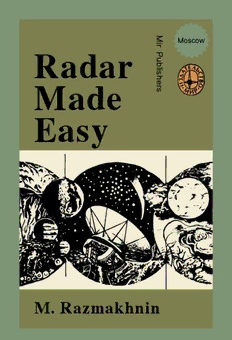
Radar Made Easy PDF
Preview Radar Made Easy
M ir Moscow Radar P u b lis h Made e r s Easy M. Razmakhnin M. K. Pa3MaXHH" VIsnaTeJ]scrBO PA,UHOJIOKAUH5I «COBeTCKoe paJI.HO» BE3 C1>OPMYJI, MOCKBa HO C KAPTHHKAMH Radar Made Easy M. RAZMAKHNIN Translated from the Russian by B. KUZNETSOV Mir Publishers Moscow UDC 621.896.96(828)= 28 First published 1973 Ha alUAutlcICoM R3btICe Second printing 1974 Revised from the 1971 Russian edition @ Translation p.0344-380 into English, 041(01) -74 Mir Publishers, 1974 Contents Foreword 7 ByWayof Explanation........ 10 PartOne. Making an Acquaintance What Is Radiolocation?.......... 14 Radars' Way into the Armed Forces-..···········..···· 19 Radar and Aviation... 22 Radar and Missiles....................................... 28 Radar at Sea............................................. 34 Radar in the Army ···· ·..................... 38 Radar and Science.. 41 Radar in Space.......................................... 44 It Is Always Among Us 48 I••I•••I III••I... PartTwo. How ItWorks Which One to Choose?....... 58 How to Take Stock of an Acquaintance?. 63 I•••••••I. How a Target is Located 67 1 How Radar Does It - I..... 77 Noise-Where It Comes from and Why·····..·.······ 84 How Radar Does It-II··..·..····....············..········.. 93 A Simpler Way ·..··..'..···..·..·..··..··..·.. 104 Uninvited Companions................................. 107 How to Send Out a Signal, Receive an Echo and Locate a Target....................................... III Everything is Sorted Out..·...· ·..··.·..·.......... 116 Target's Way of Hiding.......... 120 How Targets are Identified............... 127 We've Learned Only Part of the Story.... 132 Index 136 Foreword Bytradition, an author writes a foreword to explain what his brain-child is like, what material has been used, and who is expected to read it, and how. He is also supposed to thank as many people as he can, in cluding those he is going to confront. In this way he hopes to chain them up to his writing chariot and to forestall their criticism reliably. Since a foreword isa deep-rooted traditionin the pub lishing trade, one must write it, no matter how one feels about it. Yet a conventional foreword, as this author thinks, would be out of place in a book like this. So his choice has been a kind of dialogue in which one side will be hereafter referred to as AUTHOR, and the other side, a person acting on the strength of the publi shing code, will go under the clandestine name of P·UBLISHER. So the PUBLISHER strikes first. P. What sort of book we shall call it according-to the formal classification of literary works? A. To befrank, I find it hard to place my book pre cisely. The point is that it is in two widely differing .. parts. The first is more in the nature of scientific ad vertising, and the second approaches closely popular science, although it has been strongly influenced by 7 J. "science for fun" books now in vogue, like Williams' The Compleat Strategyst and Ya. Khurgin's So What? P. To put it another way, your book does not belong to any (arm of literary work officially established. A. Well, then let's call it popular science. P. What material have you used? A. Mostly periodicals, and some books. P. Whom is the book intended for? A. The "enlightened layman", a man with a good educational background and knowing about the subject matter only what he can learn through the mass media (radio, television, the press, etc.). This book is decidedly for him. And, of course, for school graduates and any one interested in radar. It is not unlikely that radar specialists too will leaf through it. Of course, they will be attracted not so much by the subject-matter as by the drawings made by E. Treskin. They deserve it. P. How should your book be read? The question may sound strange, but there.are books in which the authors suggest the reader read first, say, chapters 1, 2, 4, 7, and 3, then chapter 6, then chapter 1 again. A. The text may be read in normal sequence, and the drawings from beginning to end or the other way round. P. May your book serve as a study aid? A. Positively not, for all the author's effort to present some chapters as they would be in a text-book. In fact, some chapters contain problems for the reader to work out on his own, but nothing will happen if he chooses not to. The succeeding chapters will be easy to un.. derstand anyway. The more elaborate situations are numbered and discussed in that order. The author has made it a point to note both merits and demerits of all the methods and techniques discussed. In this, the au thor has tried to be objective. Still, the book cannot be 8
